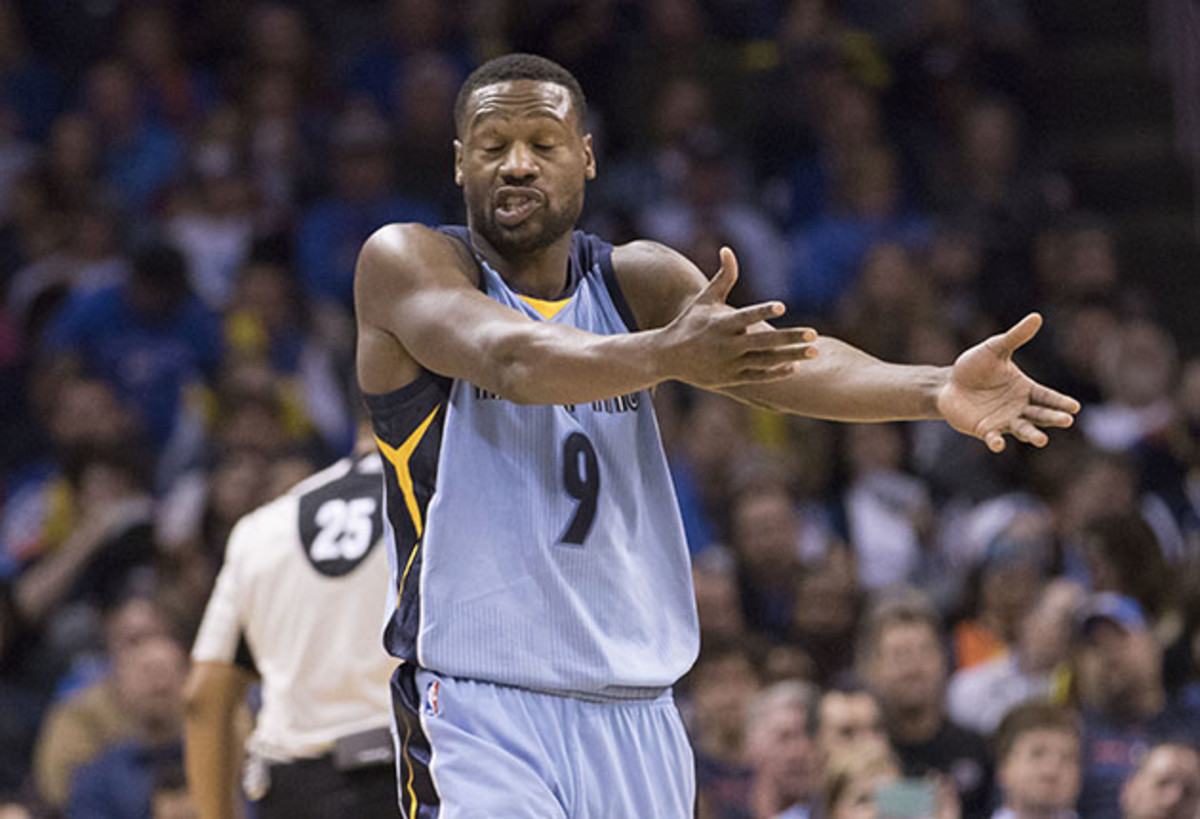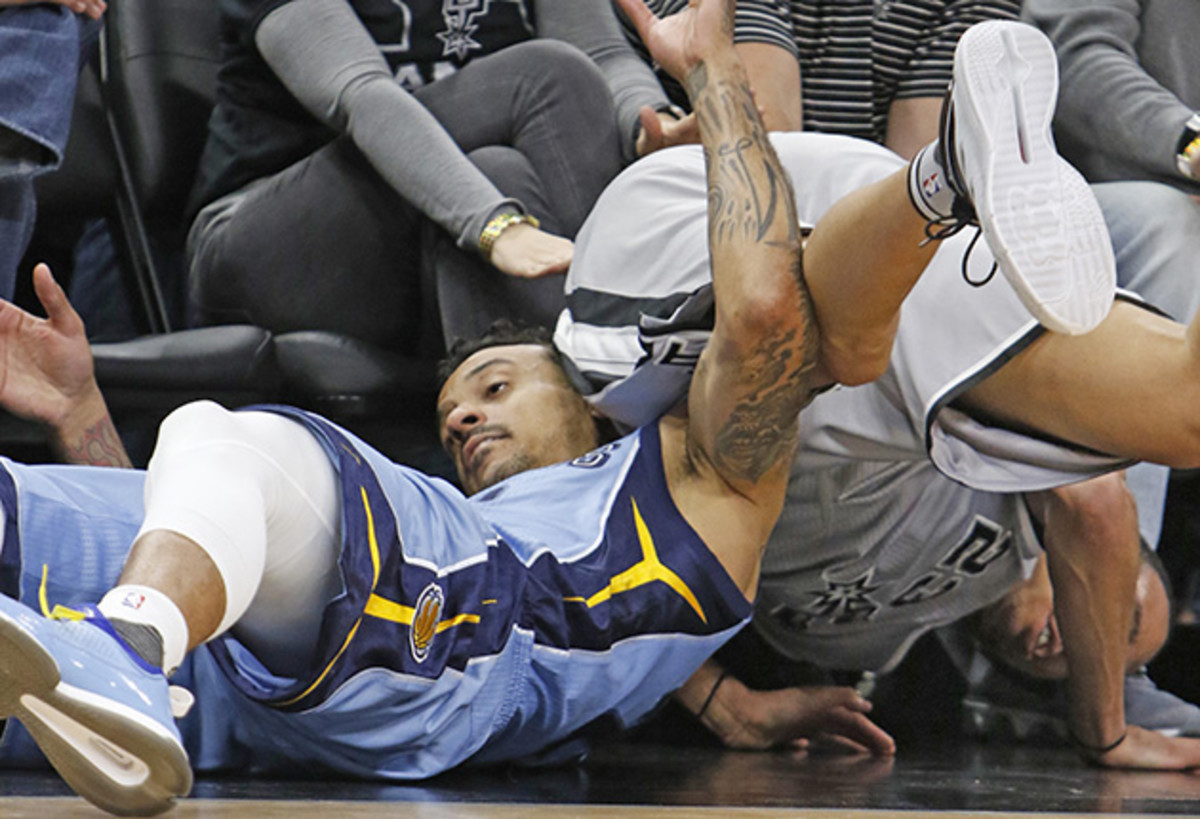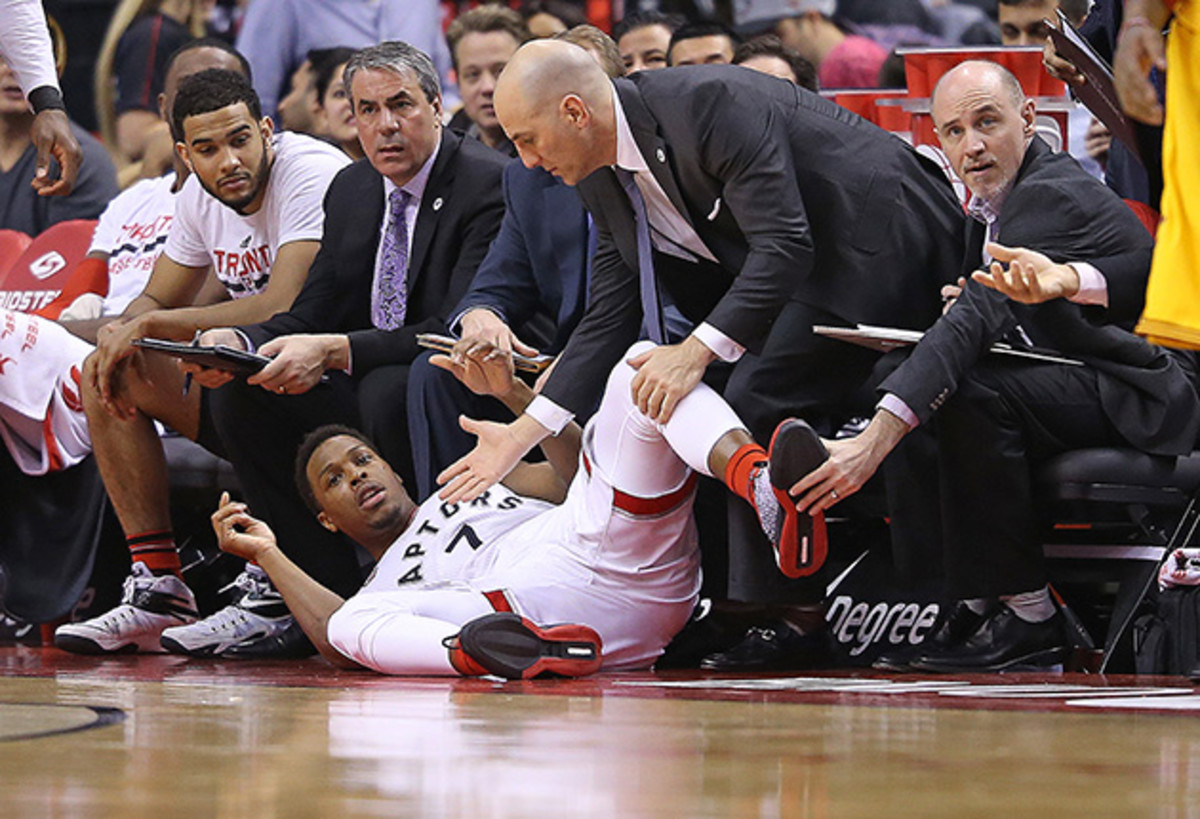The Floppies: The most ridiculous dives of the 2015–16 NBA season

Do you have a dollar? What about a quarter? Or a penny? If so, mail it to commissioner Adam Silver and you will have magically contributed more money to the league’s than all 400+ NBA players have paid in flop fines this season.
That’s right, through Monday’s action, the NBA’s anti-flopping program, which is in its fourth season after being instituted by former commissioner David Stern in 2012, has yet to issue a single monetary fine. Remember, the league only hands out fines for repeat offenders who have already been given a free warning. So far this season, only eight warnings have been issued, which is down sharply from the 30 handed out at this same point of the 2014–15 season. No player has been dinged twice.
Season | Flops | Fines | Total Fine $ | Players | Teams |
|---|---|---|---|---|---|
2012–13 | 24 | 5 | $25,000 | 19 | 13 |
2013–14 | 33 | 6 | $30,000 | 27 | 19 |
2014–15 | 30 | 3 | $15,000 | 27 | 17 |
2015–16 | 8 | 0 | $0 | 8 | 7 |
• MORE NBA: Wiggins, Wolves need each other | NBA mock draft
Last year at this time, SI.com noted that the anti-flop program didn’t seem to be a major point of emphasis. This year, it’s been basically nonexistent. The league hasn’t issued a flop warning since Jan. 27. Players have been fined at least $10,000 for requesting a trade, kicking a chair, doing the “Big Balls dance,” throwing a water bottle, and throwing a seat cushion into the stands, and yet no one has had to pay up for taking a dive.
Given this background, it’s fair to wonder whether fans and observers would even notice if the anti-flop program was disbanded for the 2016–17 season.
Kiki VanDeWeghe, the NBA’s Executive Vice President of Basketball Operations, told SI.com by telephone Wednesday that the program will continue next season without major changes despite its lack of activity. Or, perhaps, because of its lack of activity.
“The program is working,” VanDeWeghe said, arguing that the threat of a fine was discouraging the behavior. “When you put in these types of programs, they take a couple of years to get going. … It’s accomplishing what we want it to accomplish.”
Back To The Future: Kemba Walker's search for NBA playoff magic
VanDeWeghe, a former NBA player who assumed his post last summer after Rod Thorn retired, noted that the administration of the flop program hadn’t changed meaningfully since he took over. The drop in flops isn’t the result of a weakened or modified enforcement policy, in VanDeWeghe’s eyes, as the executive traces his own disdain for flopping back to his playing days at UCLA during the 1970s.
“I’m going to hearken back to the Dick Harter days,” VanDeWeghe said, referring to the Oregon Ducks coach from 1971–1978. “He was a fantastic coach who preached a tough style of defense. They were masters of taking charges. … They used to take charges [in the open court] by jumping right in front of you. I used to hate that.”
VanDeWeghe pointed to three key developments during the anti-flop program’s four-year existence that might help explain the drop in flops.
1.He believes that a “better understanding of working together” has developed between players, teams and referees thanks to the formalized flop protocol. The rules and guidelines have helped set expectations for all sides, eliminating some of the most egregious behavior that was allowed to go unchecked for years before 2012.
2.He believes referees have improved their ability to differentiate between flops and real contact by “identifying patterns of flopping” (like launching the head backward) and working to refine their skills. That type of improvement theoretically reduces the number of controversies generated by incorrect calls that might influence a game’s outcome.
3.He believes the NBA’s enhanced transparency regarding all of its referee decisions—highlighted by the release of the “Last 2 minute Reports”—has increased buy-in from all sides. Ensuring the fairest possible shake in late-game situations should incentivize respectful, rule-abiding play throughout the rest of the game.

The flops assessed this year do offer supporting evidence for some of these conclusions. For example, three of the eight flop warnings came on plays that were not ruled fouls during the course of play. In all three cases, the flops ranged from “fairly convincing” to “theatrical,” meaning the officials deserve a nod of appreciation for not getting duped.
And while it’s difficult to truly judge the “scale” of any individual flop, this year’s warnings don’t compare to the ludicrous full-court helicopter spins the NBA has seen in years past. There are some serious acting jobs to be seen this year, without question, but they’re not quite as over the top as in years past.
For those wondering why the NBA doesn’t retire the program if player behavior has in fact been corrected, VanDeWeghe made reference to at least two reasons the program should stay.
1.The league removes the free warning during the playoffs, giving it a punitive mechanism to react to a potentially game-altering or series-changing flop that takes place under the increased postseason glare.
2.Perhaps more importantly, there’s always the possibility that removing the flop program would lead to a subsequent rise in flopping by players who no longer feared punishment or public shaming.
Even though there were fewer flops this season, and fewer truly foolish flops, the flop didn’t go extinct. In fact, there were still some pretty funny flops.
So, withoout further ado, let’s plunge forward with the fourth rendition of The Floppies, SI.com's annual tradition of recognizing the very best in foul simulations. In case you missed them, be sure to check out the 2012–13 edition, the 2013–14 edition and the 2014–15 edition. Note: In years past, this has been a top 10 list, but there have only been eight official flops to rank this time around.
Floppers of the Year (Team): Grizzlies
There’s no discussion or debate to be had because only one team has drawn multiple flop warnings this season: Memphis. Remarkably, both of the Grizzlies violations—one to Matt Barnes and one to Tony Allen—came in the first eight games of the season and the team has been flop-free ever since.
Even more remarkably, notorious flopper Lance Stephenson and SI’s 2015 Flopper of the Year P.J. Hairston, both acquired by the Grizzlies in midseason trades, have managed to entirely escape the league’s wrath this year.

Flopper of the Year (Individual): Matt Barnes, Grizzlies
Without any repeat flop offenders this year, it’s impossible to really weigh the “bodies of work” of each of the eight floppers listed below. Suffice it to say, however, that no other flopper in 2015–16 found himself embroiled in as much hot water with the league office as Barnes.
The hot-headed Memphis forward was suspended two games in December for his role in an off-court altercation with then-Knicks coach Derek Fisher, fined $35,000 for saying that “violence is never the answer, but sometimes it is” in response to the Fisher incident, and then suspended for one game in March for following Bucks big man John Henson to the locker room after an on-court incident. What’s more, Barnes took a shot at Fisher breaking the “guy code” following D’Angelo Russell’s recent saga in Los Angeles and called his former teammate a “snitch” in various social media posts.
None of this has anything to do with flopping, but the nonsense will serve as our tie-breaker. Barnes’ flop, by the way, was one of the league’s most egregious (as you’ll see below).

Flops of the Year
Without further ado, the following are SI.com's top eight flops of 2015–16. Only officially designated flops were eligible for consideration. The absurdity of each play was the chief criterion in developing these rankings, with bonus points given to arm and head flailing, spinning, overreacting to zero contact, and uniqueness.
8. Paul Millsap flops on Dwight Howard
[youtube:https://youtu.be/cnvpi-CYRXc]
Of course, the NBA’s most unassuming All-Star had this year’s least interesting flop. After losing a rebound to the taller and stronger Howard, Millsap launches himself forward after a light push from Howard’s left arm. This is textbook stuff: he yells, lets his legs go, and spins as he descends to the hardwood, where he rolls a little bit for good measure.
A little boring, yes, but also effective. Howard was hit with a foul on the play.
7. Tony Allen on George Hill
[youtube:https://youtu.be/WW6RcH2YHtU]
Now we’re getting places. As Allen dribbles the ball up the court, he takes a slight bump to his left side from Hill, who is trying to direct him towards the sideline. Allen responds by flailing his head back and briefly going off-kilter, a totally unnatural reaction that draws immediate boos from the Indiana crowd.
This flop is actually a sign of progress on the part of the NBA’s officiating crew. While Allen’s simulated reaction is pretty convincing in real time, it doesn’t fool the stripes into blowing their whistles. Instead, “First Team All-Defense” has to proceed into the frontcourt and initiate the offensive possession.
• MORE NBA: Blake Griffin's return makes Clippers whole again
6. Anderson Varejao flops on Festus Ezeli
[youtube:https://youtu.be/7cVifinXpd8]
With only eight flop warnings being assessed this year, there are surely dozens of acting jobs going unpunished this season. Varejao’s big mistake? He tried to hit the deck during a nationally-televised game between the Cavaliers and the Warriors, the two teams that squared off in the 2015 Finals. Instead of flying under the radar, Varejao was doing his dirt under the microscope.
Report: Grizzlies’ Mike Conley (Achilles) likely out for rest of season
This was standard, big-on-big overreaction: Ezeli attempts to come across the paint and Varejao steps in front of him, ready to launch backwards and hit the back at the first sign of contact. Sure enough, Varejao flies backwards as soon as he feels the touch from Ezeli’s bent left arm. The officials hit Ezeli with a foul, much to his chagrin, and TNT broadcaster Chris Webber didn’t mince words in his assessment. “Oh my god, I guess that’s a good flop because he made him believe it. … Great flop right there, getting another play, an extra possession.”
The combination of the bad whistle and Webber’s enthusiastic assessment left the league office no choice but to punish Varejao’s behavior. Clearly, there were no hard feelings from the Warriors, as they signed Varejao about a month later following a midseason trade and buyout.
5. Drew Gooden flops on Kelly Olynyk
[youtube:https://youtu.be/NR4fyC9sV7E]
It’s not every day that you get to see a grown man’s body buffer like it’s struggling with a slow wi-fi connection. Really, Gooden almost looks like he’s being “Screwed and Chopped” after he takes the lightest of taps from Olynyk on his back during a rebounding situation.
This was crafty desperation: Gooden knew the defensive rebound was caroming over his head and he felt he had no other choice but to allow his body to buckle, repeatedly, under the massive force of Olynyk’s feather fingertips. The best part: it didn’t work and he had to turn around and play defense with a world of shame weighing on his shoulders.
• MORE NBA: How does Thon Maker project to NBA?
4. Kyle Lowry on Bobby Portis
[youtube:https://youtu.be/VCTBsS6doVs]
This is a technician’s flop. One can imagine Chris Paul watching the tape of this one and nodding his head in silent appreciation. First, Lowry smartly picks his target in Portis, a hyperactive and slightly out-of-control rookie big man. Second, he unveils it at the right time/score situation: down nine after an empty possession midway through the fourth quarter. Third, he disguises his action by beginning the sequence with a basketball play: reaching in trying to poke the basketball out of Portis’s hands. Fourth, he sells out with a full backwards launch and lunge after a phantom elbow. Fifth, he puts the cherry on the cupcake by holding his chin in pretend pain. Sixth, it works!
The immediate, angry reaction from both the United Center crowd and the Bulls’ bench only completes the scene. Look at Aaron Brooks fist-pumping in anger and flying around the court like no one cares that he just got mugged in broad daylight. Look at Portis turning his palm up, as if to say, “Really, bruh?”
3. Brandon Knight on Pau Gasol
Knight looks like an inebriated figure skater executing a poorly-rehearsed combination as he tries to draw a foul on Gasol in the paint. First, Knight throws his right arm up and tilts his head back as Gasol tries to untangle himself. When that doesn’t work, he veers into Gasol’s chest and launches himself backwards like a crash test dummy, throwing both arms and his head back while letting his legs go. Clearly, this is a man who has experience playing dead (Thanks, DeAndre Jordan). He was so convincing that teammate Mirza Teletovic came over to check on his well-being.
Again, kudos to the referees. This sequence came with under two minutes left in a one-possession game. An incorrect foul call would have had major implications. Despite Knight’s best efforts, and his repeated efforts, the referees let play continue.
The SI Extra Newsletter Get the best of Sports Illustrated delivered right to your inbox
Subscribe
2. Matt Barnes on Chris Paul
In slow motion, Barnes’s flop looks like a stunt from “Crouching Tiger, Hidden Dragon” or, maybe, like he’s being punched in the face by an invisible, floating Derek Fisher as revenge for their off-court incident.
The “launch” is a popular flopping technique, but rarely do you see a player launch himself so forcefully while he has the ball, let alone while he is in his shooting motion. Down four with less than 10 seconds left, though, Barnes clearly felt getting fouled—real or otherwise—was the best way to get some points and stop the clock. Even though Paul never touched him, Barnes flew backwards and then stumbled further backwards, careering from near the three-point line out towards the center court logo while chucking a desperation three-pointer.
Against all odds, the plan worked. Even better, it worked against Paul, who has been known to turn to “gamesmanship” every once in a while, and it came against his former team in a potentially game-altering play.
1. J.J. Redick flops on Kent Bazemore
[youtube:https://youtu.be/Bfutl3MtLkc]
This year’s “Flop of the Year” is an absolute work of art. It’s also totally counterintuitive. Redick doesn’t flop in a late-game scenario (it comes just before halftime). He doesn’t flop because he’s up against the shot clock (there’s 14 seconds left). He doesn’t flop in a rivalry game or a high-profile affair (it’s just a late January game against the Hawks). He doesn’t flop on a high-value three-pointer (it’s a mid-range jumper). He doesn’t flop in response to any contact (there is none!). He doesn’t even fall to the ground (he lands on his feet).
Indeed, Redick’s flop goes against just about every flopping principle we’ve come to understand over the last four years. This is creative genius.
After pump-faking near the arc to lose Bazemore, Redick steps into a mid-range jumper near the elbow. Knowing that Bazemore might be recovering to guard him from behind, and knowing his own body is between the nearest referee and Bazemore, Redick splays his legs like the “Jumpman” logo to simulate Bazemore knocking him off course.
The ensuing shot airballs badly, but Redick’s deception works perfectly, which immediately draws the ire of Atlanta’s broadcast team. “They’re going to call a foul on that?” exclaimed Hawks announced Bob Rathbun. “I know Staples Center is close to Hollywood, but come on! He wasn’t even in the same area code!”
Then, the camera panned to coach Mike Budenholzer who looked beside himself and later to Bazemore, who didn’t mince words in expressing his frustrations to the referees.
Even though Redick’s body is behind the basket, this angle best captures how wide open he was when he decided to unleash his flop monster. Ladies and gentleman, your 2015–16 Flop of the Year.
